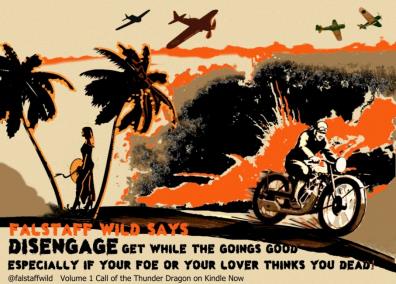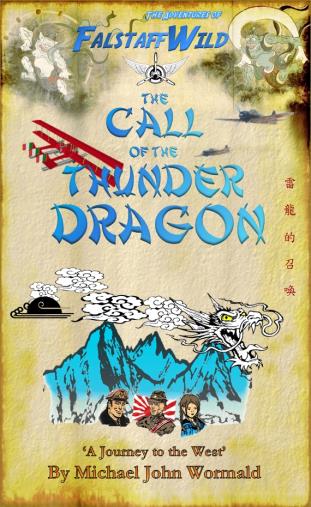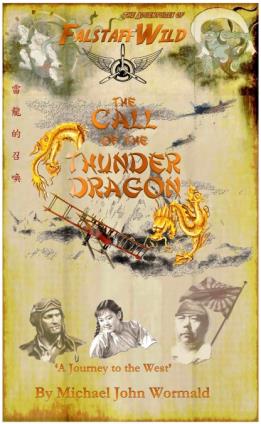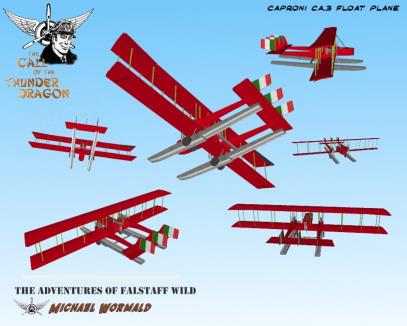The Call of the Thunder Dragon (67 page)
Read The Call of the Thunder Dragon Online
Authors: Michael J Wormald
Tags: #spy adventure wwii, #pilot adventures, #asia fiction, #humor action adventure, #history 20th century, #china 1940s, #japan occupation, #ww2 action adventure, #aviation adventures stories battles

Suddenly the aircraft bumped as
if he’d hit a barrage balloon. There was nothing there, the
knocking continued, the air turbulence carried them downwards in a
series of juddering steps.
Outside the canopy, Falstaff saw
a storm that seemed to have come out of nowhere.
Falstaff wafted the cigar smoke
aside and swore. “Bugger!” Was all he had time to say. Pulling the
yoke back, he accelerated pushing the throttles to speed his hasty
climb.
Ahead of him rising out of the
mountains was a thick grey column of dense black cloud. Flashes of
lightening bracketed its flanks, the rain skirting its side with
silver scales. Lightning danced along the wings and thunder boomed
around the cabin.
Akira woke with a start. “Nan des
ka? What have you done now?” He croaked.
The lights went out and the
instruments flickered. The engines stopped and the propellers spun
to a halt with a dull whine.
Falstaff smirked, as he reached
for the circuit breakers and throttles.
“Hold on to your buns ladies!
We’re going down!”
The End
###
Falstaff will return in another
adventure soon, for your entertainment and pleasure...
Returning in:
‘
The
Orange Dragon of Old Hanoi.’
June 3rd, 1940
Singapore
Falstaff straightened the collar
on his black dinner jacket as he strode into the Raffles’ saloon
bar.
Despite the war in China and the
disruption of trade with Japan, life in Singapore was as exultant
as ever. Admittedly, the presence of a British battalion newly
returned from Plague threatened and Japanese infested Shanghai,
along with the reinforcements from Australia were difficult to
ignore, but the high life in the crucial gateway, the jewel of the
Colonial East, continued nonetheless.
Falstaff took a cigarette
proffered from a silver case, nodding his curt thanks as it was lit
for him by a flunky in tails and white gloves.
“Will you be dining in tonight,
sir?”
“No, not tonight, the club; I’ll
be going down to the Dragon’s Nest, I hear that hotsy-totsy Rio is
appearing tonight and she’s gonna bring the house down!”
F alstaff Wild says:
alstaff Wild says:
Alternative
Cover:

O riginal Cover:
riginal Cover:
T he Caproni Ca.3 or Ca.39 Float Plane
he Caproni Ca.3 or Ca.39 Float Plane
From Falstaff
Wild Aircraft Reference.
Endnotes
1
‘Seh
lang’ liúmáng? Chinese; ‘pervert’. ‘Hua Hua Gong zi’ a
Flower-Flower, a playboy.
2
Chinese Shu = Xi, Ximahe River
3
Pu’er China, as in the Tea growing region, sometimes known as
Pu-erh Tea
4
Brooklands was a 2.75-mile (4.43 km) motor racing circuit and
aerodrome built near Weybridge in Surrey, England, 1907 to 1939
5
Falstaff may not know it the designation for the float/sea Caproni
Ca. 3 version was Ca.39
6
1919
Verona Caproni Ca.48 crash
7
Lake
Meizihu the Plum lake, Pu’er
8
Sensei – teacher/master(guru) Dono, lord/’my master’ Japanese
honourifics
9
See
‘Falstaff Gets into Hotwater’
10
Gomennsai, Japanese I’m sorry
11
A Chinese sword shaped like a curved meat cleaver; also known as
the ‘big-sabre’.
12
Mafeng – Hornets
13
Meizi Plum Lake derives its name from Maisie River
14
Guwahati is two Assamese words: 'guwa' (the
areca nut) and 'haat' (market place) Pronounced Gowhatty,
anglicized to Gauhati during British rule. The name changed to its
present form in 1980s to conform to local pronunciation.
‘Guwahati’
15
Chikushoo, Japanese, Damn it
16
Kawanishi Aircraft manufacturer. It was founded 1920 in Hyōgo as
part of the Kawanishi conglomerate, which had been funding the
Nakajima Aircraft Company. Best known for float planes, its First
aircraft the K-1 Mail-carrying Aircraft in 1921 before the
Kawanishi Type 97 H8K (Emily) flying boat able to carry up to 60
troops.
17
Haji; Japanese for Shame. Japanese are mindful and evaluate the
eyes of others to avoid shame. They have very high self-esteem,
limited only by their own merit and credentials; thus, they would
typically never attempt to do the work of others or even face
higher authority. They always think how to avoid being put to
shame. If one is shamed, they are wounded emotionally. They are
afraid of being in such a situation. As such, there is a culture of
shame in Japan, used as a social control.
18
Irrawaddy River or Ayeyarwady River (or 'Irawati' River in
Hindi)
19
The Poem Mandalay by Kipling, 1919 was later adapted to song with
Music by Oley Speaks and was sung by Lawrence Tibet in the 1934
film ‘Mandalay’
20
Jute the name of the plant fibre that used to make burlap, Hessian
or gunny cloth.
21
Saya – Japanese wooden scabbard for the blade.
22
Gefreiter rank, since the 16th century, usually the second rank or
grade to which an enlisted soldier could be promoted.
23
By Jan 1942, The British faced growing
numbers of Burmese insurgents. The British in Burma suffered from a
confused, rapidly changing command. Until 1937, the defence of
Burma had been the responsibility of the Indian Gov. From 37 the
Burmese gov. was in charge until Sept.39 then Comander-of-Staff in
London took operational control while the Burmese government
retained administrative control. In Nov. 40 operational control
moved to Far East Command in Singapore, while administrative
control was split between the War Office & the Burmese
government. Dec.41 control went back to the Comander-in-Chief in
India, two weeks after the first Japanese troops invaded, Burma
control was given to Gen. Wavell's new S-W Pacific Command, which
was promptly overrun by the Japs.
24
A
career in the Indian Police was certainly not the first choice for
a gentleman. Dickens' son; Francis Jeffrey tried several careers
before joining the Bengal Police in 1864.
25
There was a Japanese dentist in every
garrison town in India looking after the teeth of the British &
their families, providing cheap & excellent treatment & no
doubt learning plenty of military information? A British army
officer believed that his pre-war Japanese barber outside the army
camp in Malaya was later one of the Japanese officers guarding
POW’s in Changi.
26
Nov 1941, U Saw went to London, to illicit a promise from Churchill
that Burma be granted Dominion status after hostilities in Europe;
at the same time, Saw was already in contact with Japanese to
secure his own political future in event of Japanese invasion of
Burma. The British discovered incriminating papers relating to
these communications & he was detained for 4 years in Uganda.
This proved Saw may have been a unique position to inform the
British of Japanese invasion plans (Dec 1941) before they were
enacted on.
27
Ba Maw was arrested for sedition 6 Aug 1940 & spent over a year
in jail as a political prisoner; he was incarcerated in east Burma.
During the Japanese invasion, 1942, Maw was freed & asked by
the Japanese to head a provisional civilian administration
subordinate to the Japanese military. Ba Maw’s ‘independent’ Burma
decaled war on the allies... until the war turned against the
Japanese.
28
Kimpatsu – blonde hair. Un-Japanese.
29
Die with honour
30
Daimyo, General Japanese, feudal leader subordinate only to Shogun,
term used equivalent to medieval era 9
th
to
19
th
century Japan.
31
‘coup dans le mille’ a direct hit
32
PHD theology Harvard Divinity school Baptist Missionary
Association
33
Non-rhoticity, inability to pronounce (or difficulty in
pronouncing) r typical of Boston accent.
34
Ooozie – Elephant Handler, Burmese Mahout (Assam & India)
35
Judsons - Adoniram Judson is often called America's first foreign
missionary. The Burmese king in fact assumed Judson was an English
spy & in 1824 when the first Anglo-Burmese War broke out,
Judson and other English men were imprisoned for a year. It was
1826 when the dictionary was completed.
36
Minami Masuyo the name adopted by Colonel Suzuki whilst undercover
before 1941.
37
Yomiuri Shimbun a Japanese newspaper published in Tokyo, founded in
1874 one of five national newspapers.
38
Rangoon University: was the centre of the anti-colonial movement. 3
nationwide strikes against the British colonial government (1920,
1936 and 1938) began there, which also produced a number of future
senior Burmese politicians, including ‘Aung San’ (leader of the 30
comrades; under IJA Colonel Suzuki aka Minami Masuyo) and ‘Ba
Maw’.
